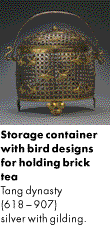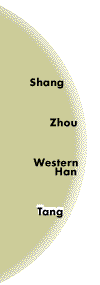
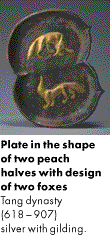
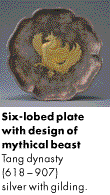
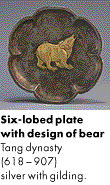
These three gilded silver plates were part of a cache of 270 gold and silver objects, foreign coins, and jades, found in two large pottery urns that were buried at Hejia village, south of Xi'an, probably to safeguard them from looters during a great rebellion that began in 755. The variety of animals featured on these objects embodies the cosmopolitanism of the Tang empire. The fabulous single-horned winged horse recalled West Asian mythical animals; the bear was indigenous to the northern forests; the two foxes may have been inspired by Chinese folk tales. Equally foreign in origin was the repoussé technique, whereby the gilded motifs on the silver plates were first raised in relief by hammering from the reverse of the plate. The foreign silversmiths who brought the technique, along with their wares, made a lasting contribution not only to Chinese metalwork, but to China's native lacquer and ceramic industries as well.
